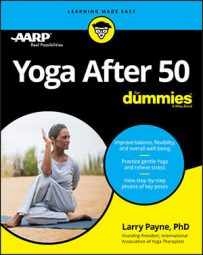- You are more prone to injury.
- Injuries may be more serious and probably will have a greater impact.
- Injuries will take longer to heal.
Knowing this should be a huge incentive for you to make sure that you’re giving adequate attention to your ability to maintain balance.
In the following discussion, I cover postures that will challenge your sense of balance:
- Balancing cat
- Karate Kid
- Tree
- Warrior III at the wall
Balancing cat
Balancing cat, shown in the following figure, is great for working on your balance because you are near to the ground. Also, you will feel your core muscles engage as you try to maintain your balance, which makes this pose is one of the best for abdominal strengthening.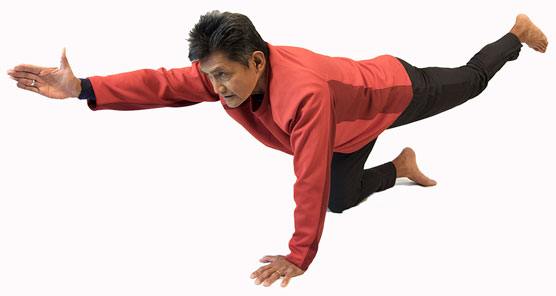 Balancing cat pose.
Balancing cat pose.To get into this pose:
- Beginning on your hands and knees, position your hands directly under your shoulders with your palms down, your fingers spread on the floor, and your knees directly under your hips.
- Straighten your arms, but don't lock your elbows. As you exhale, slide your left hand forward and your right leg back, keeping your left hand and right toes on the floor.
- As you inhale, raise your left arm and right leg to a comfortable height, as Figure 9-2 illustrates.
- Stay in Step 3 for six to eight breaths and then repeat Steps 1 through 3 with opposite pairs (right arm and left leg).
- As you start to extend your arm and opposite leg, keep your hand and foot on the ground first; then lift off the ground, one at a time.
- Just extend your arm and keep both knees on the ground.
Karate Kid
This standing pose, known as Karate Kid, develops your overall balance while it strengthens the legs, arms, and hips — all parts of the rest of the body that help support your ankles.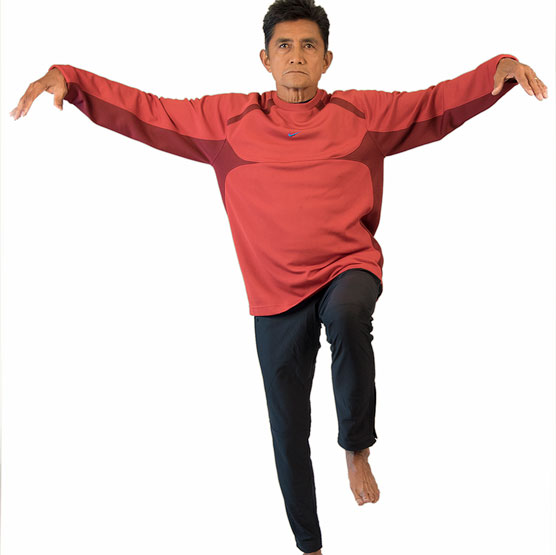 Karate Kid pose.
Karate Kid pose.To get into this pose, stand upright on your mat:
- As you inhale, raise your arms out to the sides parallel to the line of your shoulders (and the floor) so that they form a T with your torso.
To steady yourself, focus on a spot on the floor 10 to 12 feet in front of you.
- As you exhale, bend your left knee, raising it toward your chest, while keeping your right leg straight
- Remain in this posture for six to eight breaths.
- Repeat this sequence using the right knee.
- Stand near a wall so that you can use it for support. You can touch the wall with one hand. Remember, you can always take your hand off the wall as your balance improves.
- Keep your knee directly in front of you and don’t worry about how high you can lift it. The primary purpose of this pose is just to work on your balance.
Tree
When you see Yogis on magazine covers or perhaps on social media posts, it seems like the pose most often chosen is the tree pose. It’s a classic balance posture that works your muscles and joints from your ankle and foot all the way up to your arms and shoulders.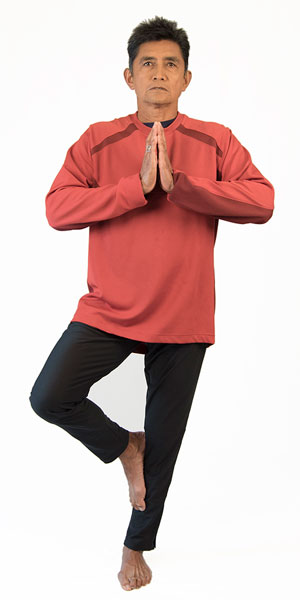 Tree pose.
Tree pose.To get into this pose, stand upright on your mat:
- With your feet at hip width (down from the sits bones, not the outer curves), hang your arms at your sides, palms turned toward your legs. The sits or sit bones is the term for the bony parts your feel underneath you when you sit up straight on a firm surface.
- Visualize a vertical line connecting the opening in your ear, your shoulder joint, and the sides of your hip, knee, and ankle. Look straight ahead, with your eyes open or closed.
- Remain in this posture for six to eight breaths. To modify the pose to make it more accessible:
-
- Don’t hesitate to practice this pose near a wall — even if you choose not to use it.
- Lower the foot on your upper thigh to the inside of your calf, just below your knee. It’s best to rest your foot either above or below your knee joint, but not right on it.
- Hands can even be on your hips if that helps you balance.
- If having your foot anywhere on your inner leg seems too challenging, you can use the kickstand technique where the big toe of the lifted leg can actually be on the ground.
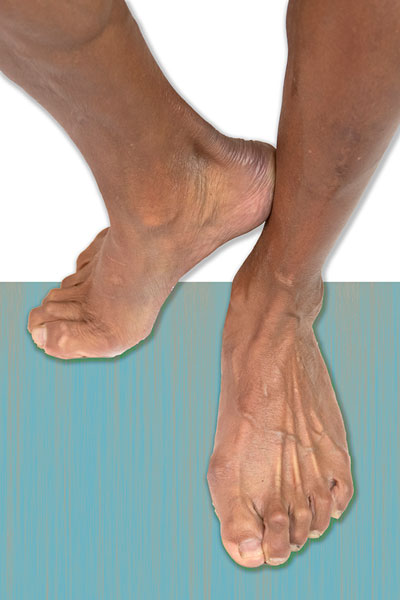 Kickstand technique.
Kickstand technique.Warrior III at the wall
This variation of the classic warrior III pose challenges your body to stretch and hold while demanding a lot of focus to retain your balance.To get into this pose:
- Stand on your mat, facing a blank wall (about three feet away).
- As you exhale, bend forward from the hips and extend your arms forward until your fingertips are touching the wall. Adjust yourself so that your legs are perpendicular and your torso and arms are parallel with the floor.
- As you inhale, raise your left leg back and up until it's parallel to the floor.
- Stay in Step 3 for six to eight breaths.
- Repeat this sequence with the right leg.
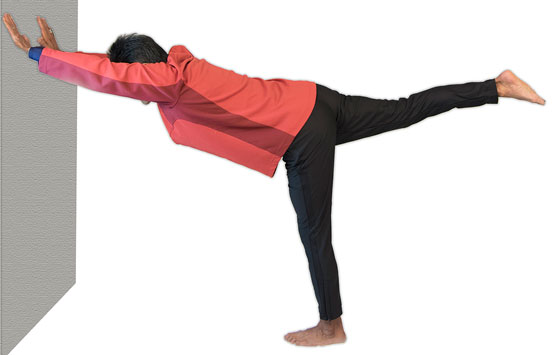 Warrior III at the wall.
Warrior III at the wall.To modify the pose to make it more accessible:
- Warrior III is traditionally done without the wall, so the preceding steps are already making the pose more accessible.
- Remember the concept of forgiving limbs. Feel free to bend your supporting leg and extended arms, softening them just enough to make the pose more comfortable.

